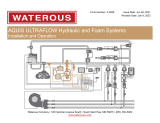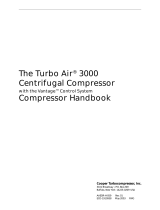Page is loading ...


Table of Contents
Safety 4
Safety Precautions 4
Safety Notices 4
Introduction 6
Using this Document 6
Viewing the Document Electronically 6
Printing the Document 6
Product Overview 7
Non-Piloted Intake Pressure Relief Valve Components 7
Installation 8
Installation Overview 8
Preparing for the Installation 8
Modifying the Equipment 8
Determining the Discharge Location 8
Dimensions—Factory Installed 9
Dimensions—Separately Mounted 10
Installing the Separately Mounted Valve 11
Operation 13
Maximum Flow Rate Chart—50 to 250 PSI 13
Maximum Flow Rate Chart—250 PSI 14
Adjusting the Valve 15
Maintaining the Valve 16
Preventing Valve Damage 16
Maintenance 17
Replacing the Valve Seal 17
Service Parts 19
Valve Components—Factory Installed 19
Valve Components—Separately Mounted 21

Safety Introduction Product Overview Install ation Operation Maintenance Service Parts
4 | 23
Safety Precautions
• Read and understand all the associated documentation before you begin the
installation.
• Read and understand all the notices and safety precautions.
• Be aware that these instructions are only guidelines and are not meant to be
definitive. Contact Waterous when you have questions about installing,
operating, or maintaining the equipment.
• Do not install the equipment if you are not familiar with the tools and skills
needed to safely perform the required procedures—proper installation is the
responsibility of the purchaser.
• Do not operate the equipment when safety guards are removed.
• Do not modify the equipment.
• Regularly check for leaks, worn, or deteriorated parts.
Safety Notices
Purge all pressure before
servicing.
Liquid ejected at high
pressure can cause
serious injury.
High Pressure
•
•
Direct discharge away
from people and equipment.
Discharge ejected at high
pressure can cause
serious injury and damage.
High Pressure
•
•
NOTICE
Before Operation
• Read and understand all
the instructions provided.
• Check all fluid levels
and replenish if necessary.
• Remove all shipping plugs
and install the operation
plugs or caps.

Safety Introduction Product Overview Install ation Operation Maintenance Service Parts
5 | 23
Safety Notices—Continued
NOTICE
Modifying the equipment
can damage components
and void your warranty.
•
Do not modify the system
or any of its components.
•
Modification
NOTICE
Do not allow fluid in the
lines to freeze.
•
Remove all freezable fluid
from the lines before
storing the apparatus.
•
Freeze Damage
NOTICE
Use a drill or hand tools to
make adjustments.
Do not use an impact
driver to adjust the valve.
Equipment Damage
•
•

6 | 23
Safety Introduction Product Overview Install ation Operation Maintenance Service Parts
Use this document to install and operate your Waterous equipment. Understand
the following conditions before continuing with the document:
• The instructions may refer to options or equipment that you may not have
purchased with your system.
• The illustrations in this document are intended to convey concepts. Do not
use the illustrations to determine physical attributes, placement, or
proportion.
• Any equipment described in this document is intended to be installed by a
person or persons with the necessary skills and knowledge to perform the
installation.
• Any equipment described in this document is intended to be operated by a
person or persons with the basic knowledge of operating similar equipment.
This document is divided into the following sections:
Safety
This section describes general precautions and alert symbols that are in this
document.
Introduction
This section is an overview of the document.
Product Overview
This section describes the components that make-up the system.
Installation
This section describes the installation and initial setup procedures.
Operation
This section describes the equipment operation.
Maintenance
This section describes the maintenance procedures.
Service Parts
This section describes the service parts.
Using this Document
Use the guidelines below when viewing this document.
Viewing the Document Electronically
• View this document in landscape orientation.
• Use the table of contents to navigate directly to that section.
• Text with this appearance is linked to a reference.
Printing the Document
• The document is viewed the best when printed in color.
• The print on both sides and flip on long edge features can provide the
best results.
• Use a 3-ring binder to store the document.

7 | 23
Safety Introduction Product Overview Install ation Operation Maintenance Service Parts
Non-Piloted Intake Pressure Relief Valve Components
The pressure relief valve opens when the intake pressure reaches the operating set-point. The set-point value ranges from 50 to 250 psi. The valve is available as
a factory installed and a separately mounted version. Your application may require additional plumbing to safely direct the discharge away from people and
equipment. Make sure that you do not cap the discharge or breather hole. Doing so will injure people, damage your equipment, and void your warranty.
1
5
6
2
3
4
FeatureFeature DescriptionDescription
1Mounting flange This secures the valve to the intake plumbing.
Note: Included with separately mounted version
only—2-1/2 inch NPT.
2Mounting hardware This secures the mounting flange to the valve.
3Pressure scale This indicates the pressure relief set-point value.
4Breather hole This allows air to evacuate the valve as it opens.
Caution: Do not cap the breather hole.
5 Adjustment screw This adjusts the pressure relief set-point value—7/8
inch.
6Discharge This is the valve discharge—2-1/2 inch Victaulic x 2
inch NPT. Caution: Do not cap the discharge.
7
8
9
FeatureFeature DescriptionDescription
7O-ring This seals the valve.
8Seal This seals the discharge outlet until the pressure relief value
is reached.
9Screw This secures the seal to the assembly.

8 | 23
Safety Introduction Product Overview Install ation Operation Maintenance Service Parts
Installation Overview
The non-piloted intake pressure relief valve is typically installed at the factory.
However, you can install the separately-mounted version to an existing
application. This equipment is intended to be installed by a person or persons
with the basic knowledge of installing similar equipment. Contact Waterous with
questions about installing the equipment.
Preparing for the Installation
Read and understand all the installation instructions before installing the
equipment. Prepare a suitable, well-lit area, and gather all the necessary tools
before you begin the installation.
Modifying the Equipment
This equipment is intended to operate as designed. Do not remove, modify, or
change the components in the system. Doing so will void the warranty. Contact
Waterous for more information.
NOTICE
Modifying the equipment
can damage components
and void your warranty.
•
Do not modify the system
or any of its components.
•
Modification
Do not modify the system or any components. Doing so will void your
warranty.
Determining the Discharge Location
The valve discharges water under pressure. Your application may require
additional plumbing to achieve safe operation. Consider the following when the
valve activates:
• Make sure that the valve discharges away from people and equipment.
• Make sure that you do not install equipment where it hinders the valve
operation.
• Make sure that you do not install equipment where it is effected by the valve
operation.
Direct discharge away
from people and equipment.
Discharge ejected at high
pressure can cause
serious injury and damage.
High Pressure
•
•
Make sure that the discharge is directed safely away from people and
equipment.

11 | 23
Safety Introduction Product Overview Install ation Operation Maintenance Service Parts
Installing the Separately Mounted Valve
1
2
The valve is typically installed at the factory. Use
the illustration and instructions to install the
separately mounted valve into an existing
application.
1 Locate the appropriate 2-1/2 inch NPT intake
plumbing.
2 Install the valve to the plumbing.
3 Verify that the valve operates as expected in
your application.
Note: Your application may require additional
plumbing to safely direct the discharge
away from people and equipment.

Notes

13 | 23
Safety Introduction Product Overview Install ation Operation Maintenance Service Parts
0
50
100
150
200
250
300
350
400
450
500
50 100 150 200 250 300 350 400
Intake Pressure, psi
Maximum Flow Rate through Valve, gpm
Maximum Flow Rate, 50-200 psi
Full open with 50 psi setpoint
Full open with 100 psi setpoint
Full open with 150 psi setpoint
Full open with 200 psi setpoint
Maximum Flow Rate Chart—50 to 250 PSI

15 | 23
Safety Introduction Product Overview Install ation Operation Maintenance Service Parts
Adjusting the Valve
1
2
The pressure relief set-point is adjustable. The
set-point ranges from 50 to 250 psi. A dashed-line
represents a value of 125 psi—this is the typical
testing pressure. Use the following illustration and
instructions to adjust the operating set-point for your
application.
1 Rotate the adjustment screw to adjust the
operating set-point:
• Rotate the adjustment screw clockwise to
increase the value.
• Rotate the adjustment screw
counterclockwise to decrease the value.
NOTICE
Use a drill or hand tools to
make adjustments.
Do not use an impact
driver to adjust the valve.
Equipment Damage
•
•
2 Use the flat face on the housing as a guide to
sight-in the set-point.

Safety Introduction Product Overview Install ation Operation Maintenance Service Parts
16 | 23
Maintaining the Valve
The valve does not require scheduled maintenance. However, you should
regularly inspect the valve for corrosion or damage. You should also include the
valve in your quarterly equipment test.
Preventing Valve Damage
Make sure that you drain all freezable fluid from the valve when freezing
conditions are present. Freezing fluids can expand and damage the valve or its
components.
NOTICE
Do not allow fluid in the
lines to freeze.
•
Remove all freezable fluid
from the lines before
storing the apparatus.
•
Freeze Damage
Leaving fluid in the apparatus that can freeze causes damage to the
equipment.

Safety Introduction Product Overview Install ation Operation Maintenance Service Parts
17 | 23
Replacing the Valve Seal
1
2
3
Replace the valve seal if it leaks or becomes
damaged. Use the illustrations and instructions to
install new valve seal.
Purge all pressure before
servicing.
Liquid ejected at high
pressure can cause
serious injury.
High Pressure
•
•
1 Make sure that the pressure in the system is
purged, then remove the adjustment screw
from the valve body.
2 Perform the following to replace the seal:
• Remove the screw securing the seal to the
adjustment screw and set it aside.
• Remove and discard the seal.
• Use the screw that you set aside to secure
the new seal to the adjustment screw.
Note: Do not apply thread-locker to the threads.
3 Install the adjustment screw to the valve and
adjust the valve to the desired setting. Refer
to:"Adjusting the Valve" on page 15.

Notes

20 | 23
Safety Introduction Product Overview Install ation Operation Maintenance Service Parts
Valve Components—Factory Installed
DescriptionDescription
1 Non-piloted intake relief valve sub-assembly
7Seal
8Screw—#10-32 x 3/8 inch (Note: Do not apply thread-locker to the threads.)
2 O-ring—3-3/8 x 3-5/8 inches
3 Screw—7/16-14 x 1 inch, hex head
/















